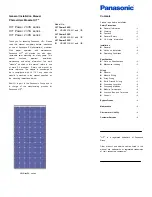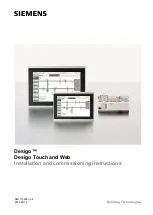
nOte
WARning
The solar module is a glass product and should be handled with appropriate
care. Do not stand on the solar module. Do not allow any objects to fall or place
any objects on the solar module, as it can cause microcracks in the cells. The
rear side in particular must be protected from scratches and similar. Never hold
or transport the solar module by the junction box or connection cables. For in-
stallation SOLARWATT strongly recommends the usage of clean, fat and silicone
oil free gloves!
Do not remove any parts or name-
plates from the solar module. Do not
install damaged solar modules.
instAllAtiOn
During installation, please take into account the locally valid
construction regulations, accident prevention regulations,
the relevant, generally accepted rules of technology and safety
regulations for working on roofs and buildings, as well as
electrical installations.
SOLARWATT solar modules must be fixed to suitable substruc-
tures, which are designed for the relevant mechanical wind
and snow loads, as well as the weight of the solar modules. The
instructions from the installation system manufacturer must
also be complied with. No mechanical stresses from the actual
building (e.g., roof truss) must be transferred to the solar
module. Have the structural suitability of the building for the
installation of a solar power system checked by a specialist.
The frame must not be mechanically or chemically processed.
Also not allowed are modifications of the solar module, such
as the conversion to the use of the heat generated in the form
of a thermal solar collector. If there is no approval in the form
of a manufacturer‘s declaration or exceptional approval, the
solar modules may not be installed in locations where there
are aggressive ambient conditions. Furthermore, the use of
the products on mobile units such as vehicles or ships is not
permitted.
During installation, avoid creating shades with the module
clips or installation system to improve the energy yield.
Comply with the minimum distance of 5 mm between the
solar modules to allow the material to expand without tension.
SOLARWATT solar modules fulfill all the requirements of the
extended test standard IEC 61215 Ed. 2, including the incre-
ased pressure load of 5,400 Pa, making them ideal for use in
areas with large amounts of snow. The local regulations or
the standard EUROCODE 1 (EN 1991-1)should be used for the
calculation of the snow loads on the module. It is important
to note that these standards are designed for impact on
structures and do not explicitly take into account the instal-
lation of solar modules.
In regions with particularly high snowfall, the pressure
load calculated in accordance with the standard based on
local snow load information may be significantly exceeded
due to snow overhang or build-up on the solar modules,
which could result in above-average stress on the bottom
frame edge. SOLARWATT therefore tests its modules above
and beyond the standard IEC 61215 Ed.2 and in accordance
with additional standards, taking into account additional
loads in the event of snow overhang or build-up to reflect
the actual loads encountered in practice and to ensure that
our products work safely throughout their entire service
life. The maximum pressure loads for the fastening methods
listed on the following pages already take into account these
increased requirements and can be regarded as the maximum
pressure load in the installation conditions taking into
account the shape coefficients in accordance with EUROCODE
1 (EN 1991-1).
Framed SOLARWATT solar modules can be fastened in a
number of ways: Please refer to the details to the following
pages.
WARning
The solar modules are not designed for concentrated irradiation. Bundling or concen-
trating solar irradiation through lenses or mirrors is therefore not permitted and can
damage the solar modules.
nOte
The solar module heats up during operation. Ensure that there is sufficient rear ven-
tilation to avoid reductions in yield. Also ensure that no flammable gases can escape
or accumulate close by.
11
Subject to change | © 2016 SOLARWATT GmbH | AZ-TM-PMS-0973 | Rev 008 | Status: 11/2016


























